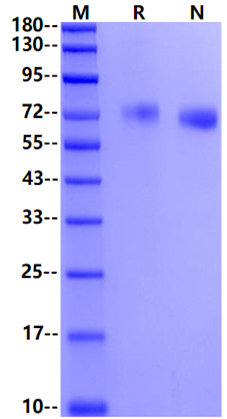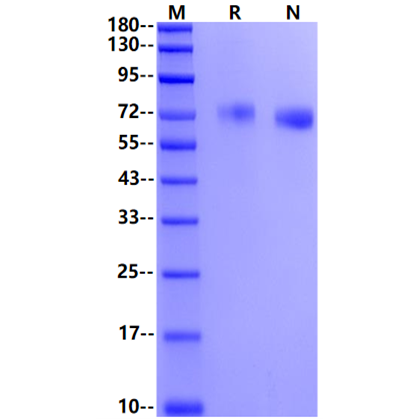1μg (R: reducing conditions, N: non-reducing conditions).
Product Details
Product Details
Product Specification
| Species | Human |
| Antigen | EphA1 |
| Synonyms | EPH Protein, EPHA9 Protein, EPHT Protein, EPHT1 Protein |
| Accession | P21709-1 |
| Amino Acid Sequence | Lys26-Glu547, with C-terminal 10*His KEVTLMDTSKAQGELGWLLDPPKDGWSEQQQILNGTPLYMYQDCPMQGRRDTDHWLRSNWIYRGEEASRVHVELQFTVRDCKSFPGGAGPLGCKETFNLLYMESDQDVGIQLRRPLFQKVTTVAADQSFTIRDLVSGSVKLNVERCSLGRLTRRGLYLAFHNPGACVALVSVRVFYQRCPETLNGLAQFPDTLPGPAGLVEVAGTCLPHARASPRPSGAPRMHCSPDGEWLVPVGRCHCEPGYEEGGSGEACVACPSGSYRMDMDTPHCLTCPQQSTAESEGATICTCESGHYRAPGEGPQVACTGPPSAPRNLSFSASGTQLSLRWEPPADTGGRQDVRYSVRCSQCQGTAQDGGPCQPCGVGVHFSPGARGLTTPAVHVNGLEPYANYTFNVEAQNGVSGLGSSGHASTSVSISMGHAESLSGLSLRLVKKEPRQLELTWAGSRPRSPGANLTYELHVLNQDEERYQMVLEPRVLLTELQPDTTYIVRVRMLTPLGPGPFSPDHEFRTSPPVSRGLTGGEGGGSGGGSHHHHHHHHHH |
| Expression System | HEK293 |
| Molecular Weight | 70-75kDa |
| Purity | >95% by SDS-PAGE |
| Endotoxin | <0.1EU/μg |
| Conjugation | Unconjugated |
| Tag | His Tag |
| Physical Appearance | Lyophilized Powder |
| Storage Buffer | PBS, pH7.4 |
| Reconstitution | Reconstitute at 0.1-1 mg/ml according to the size in ultrapure water after rapid centrifugation. |
| Stability & Storage | · 12 months from date of receipt, lyophilized powder stored at -20 to -80℃. · 3 months, -20 to -80℃ under sterile conditions after reconstitution. · 1 week, 2 to 8℃ under sterile conditions after reconstitution. · Please avoid repeated freeze-thaw cycles. |
| Reference | 1. Christian Hafner, Bernd Becker, Michael Landthaler & Thomas Vogt Modern Pathology volume 19, pages1369-1377 (2006). |
Background
EPHA1 or EPH receptor A1 belongs to the ephrin receptor subfamily of the protein-tyrosine kinase family. Receptors in the EPH subfamily typically have a single kinase domain and an extracellular region containing a Cys-rich domain and 2 fibronectin type III repeats. EphA1, EphB3 and ephrin-A3 turned out to be most prominently expressed in skin compared to other adult human tissues. EphA1 was exclusively expressed in the epidermis. The results suggest that Eph receptors and ephrin ligands are widely expressed in adult skin, especially in the epidermis, and may play an important role in skin homeostasis.EphA1 seems to be a marker of the differentiated normal epidermis and its downregulation in nonmelanoma skin cancer may contribute to carcinogenesis of these very frequent human tumors.
Picture
Picture
SDS-PAGE



